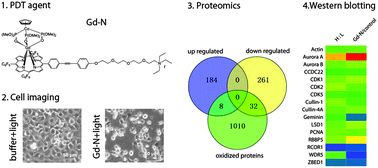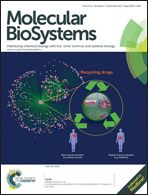SILAC-based quantitative proteomics identified lysosome as a fast response target to PDT agent Gd-N induced oxidative stress in human ovarian cancer IGROV1 cells†
Abstract
Biological systems have developed an intact network and strategies in response to various environmental pressures such as irradiation, viral invasion and oxidative stress. Therefore, elucidation of the cellular response mechanism toward oxidative stress can contribute to the knowledge of redox regulation. By using a newly developed gadolinium based photodynamic therapy (PDT) agent Gd-N and SILAC quantified proteomic analysis, we observed 485 proteins dysregulated in expression, 106 in phosphorylation and 1050 in oxidation. Interestingly, lysosome was discovered as the main organelle affected by Gd-N induced singlet oxygen, along with the down regulation of a majority of lysosomal acid hydrolases and proton pump complex ATP6V/TCIRG1. Besides, phosphorylation sites with sequence patterns “TP” or “SP” were enriched in dysregulated phosphoproteins. Protein oxidation also shows sequence patterns in target proteins with “M.D” or “KM” taking methionine as the central residue. Oxidized proteins were most enriched in the pathways of Parkinson's disease, an oxidative stress closely related neurodegenerative disease. In conclusion, our study reveals new insights into the cellular mechanism to oxidative stress and may contribute to the discovery of new targets and development of novel PDT agents.


 Please wait while we load your content...
Please wait while we load your content...